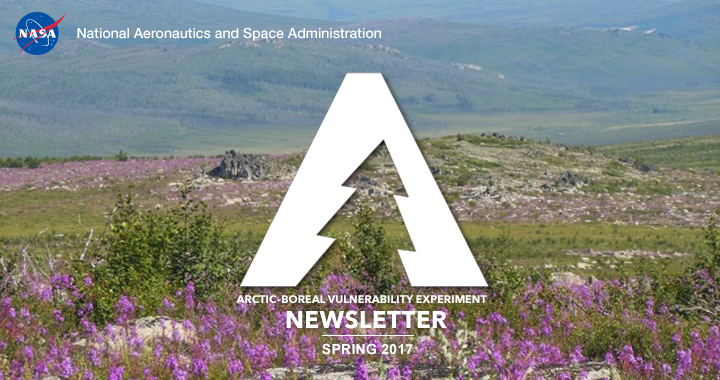|
This newsletter was distributed to participants of ABoVE activities on April 14, 2017 Airborne Planning and Science Team Meetings SummaryThe ABoVE Science Team held two sessions in Boulder, CO January 17 – 20, 2017, one focused on preparing for the upcoming airborne campaign, the other a general meeting for the Science Team. Meeting participants included both newly funded and current investigators, representatives from partner organizations and affiliated projects, support and logistics staff from the Carbon Cycle & Ecosystems Office (CCE Office) at Goddard Space Flight Center (GSFC), as well as ABoVE Program Manager Hank Margolis and Program Scientist Eric Kasischke from NASA Headquarters. 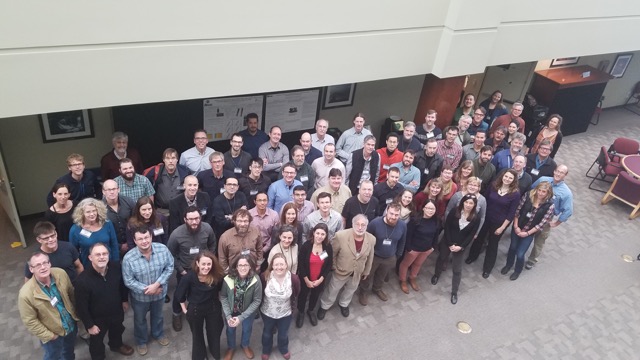
Airborne Planning MeetingABoVE Deputy Science Lead Chip Miller (JPL) convened the airborne science planning session the first morning with more than 65 participants in attendance. Representatives from each of the 9 newly selected airborne projects gave brief presentations on their projects, detailing the planned sensors and platform combinations. The projects address a range of scientific topics including permafrost and hydrology; vegetation structure and function; carbon cycle dynamics; and forecasting and modeling. A significant portion of the session was dedicated to adjusting flight plans to accommodate logistical and financial constraints. Project teams and partners (including DOE’s Next Generation Ecosystem Experiment-Arctic, POLAR Knowledge Canada, Natural Resources Canada, Environment and Climate Change Canada, and the Governments of Northwest Territories and Yukon) worked together to identify key locations for data collection that have the substantial historical data and/or scientific importance. While not every desired flight location will be able to be accommodated, the compromises identified still yield a scientifically robust plan for the airborne campaign. The Foundational Airborne measurements include L-band and P-band radars (UAVSAR and AirMOSS) and a vegetation lidar (LVIS) and a narrow-band imaging spectroradiometer (AVIRIS-NG). Other airborne instruments brought to the effort by selected airborne science teams include the Canopy Fluorescence Imaging Spectrometer (CFIS), a Ka-band radar (AirSWOT), and airborne trace gas concentrations and flux measurements. Science Team MeetingIn the second half of the 3-day meeting, numerous researchers joined the session for the general Science Team meeting, with a total attendance near 100. Science Lead Scott Goetz (NAU) along with Deputy Science Lead Miller, convened the session with reflections on the prior day and a half, and the relevance of the airborne planning efforts for the entire Science Team. Each of the ABoVE Science Team interdisciplinary working groups reported on their recent activities. The working groups presenting included: Hydrology & Permafrost Vegetation Dynamics, Fire Disturbance, Carbon Dynamics, Wildlife & Ecosystem Services, Modeling Framework & Comparisons, Collaborations & Engagement, and High resolution Imagery & Digital Elevation Models). Each working group summarized their activities and outcomes from the prior year while highlighting areas of synergistic activity and potential for collaboration on synthesis projects. Copies of the working group presentations can be found here. In addition to the first round of 25 “Phase 1” ABoVE core projects and the 9 new Airborne Science projects, there are also some 30 projects directly affiliated with ABoVE. The efforts may be funded by NASA or other sources, but are selected based on applications to the ABoVE leadership group documenting their research within the study domain (Alaska and western Canada). About a dozen of the recently added projects presented “speed talks” on their research goals and relevance to the overall ABoVE effort. ABoVE has several important partners for collaborating on research and logistics, both in Alaska and Canada. During the general session, partners gave short presentations on their research interests and activities in the ABoVE Study Domain. On the Canadian side, there were representatives from POLAR Knowledge Canada, Natural Resources Canada – Canadian Forest Service, Environment and Climate Change Canada, Natural Resources Canada – Canada Centre for Mapping and Earth Observation, Government of Yukon, and the Government of the Northwest Territories. Merritt Turetsky [University of Guelph] provided some perspective from Canadian academic institutions. From Alaska, the Science Team heard presentations from partner organization Next Generation Ecosystem Experiment (NGEE) -Arctic, as well as updates about synergistic activities being conducted by the Bonanza Creek and Arctic LTERs, and NSF’s NEON. The intent is to make it an open science meeting with all ABoVE investigators invited. Synthesis presentations will be provided by the various working groups and partner projects, but much of the meeting with be more interactive, including poster sessions. Field Operations and SafetyDan Hodkinson, Leanne Kendig, and Sarah Sackett from the CCE Office gave an overview of logistics support for ABoVE, including information about permitting; field vehicles, equipment, and technicians; safety training and planning; and the Fairbanks (AK) and Yellowknife (NWT) logistics hubs. Throughout the meeting the staff met with individual researchers to review logistics and safety needs. Liz Hoy updated the group on the ABoVE Science Cloud, including information on data holdings and high-resolution imagery. Greater than 2 Petabytes of data have already been staged on the system, including Landsat, MODIS, MERRA – GEOS-5 and DigitalGlobe Imagery. The CCE Office has also been working to develop tasking requests for both DigitalGlobe and Radarsat-2 data. Stakeholder EngagementLibby Larson reported on a pilot activity the Office is undertaking to further enhance connections with potential stakeholders. ABoVE projects will assess the “applications readiness level (ARL)” for each product the project will produce. ARLs range from 1 (basic research) to 9 (sustained operational use). Because most ABoVE projects are funded by the NASA Terrestrial Ecology Program, many of the products will fall within the lower range of the ARL scale (i.e. they are focused on research and are not necessarily applications oriented). However, the process of self-evaluation of the progress and intended uses of products will enable identification of additional potential stakeholders and possible future applications research. An additional staff member, Chalita Forgotsen, has been hired to help ABoVE projects determine ARLs for their products. Citizen Science and Professional DevelopmentPeter Griffith presented the citizen science and communications activities of the Office and the Science Team. ABoVE has partnered with Earth to Sky (ETS) an interagency partnership that conducts a variety of professional development efforts on science, and science communication for informal educators and interpreters (principally those in National Parks, Wildlife Refuges and similar public lands). ETS also maintains and nurtures an expanding community of practice comprised of ETS course alumni who in turn reach millions of people annually with content derived from our courses and resources. Last year ABoVE and ETS offered a climate science and communication mini-course in Fairbanks with participants from National Parks, AK state agencies, museums, NGOs, and university and academic programs. A regional course on the same topic is planned for April 2017 in Yellowknife, NWT, Canada. ABoVE is also working with GLOBE Observer, a citizen science program that creates protocols for individuals to collect environmental data locally on their smart phones. Airborne Campaign UpdateAfter months of intensive planning, the 2017 ABoVE Airborne Campaign (AAC) kicks off later this month with ABoVE Science Team members Colm Sweeney and Steve Conley circuiting the ABoVE domain to measure atmospheric carbon dioxide (CO2), methane (CH4) and carbon monoxide (CO) and characterize carbon fluxes during the Spring shoulder season. They will be followed in late May by flights of the UAVSAR and AirMOSS sensors to characterize the active layer immediately post-snow melt. In July the LVIS and AVIRIS sensors will overfly the domain to characterize ecosystem structure and function near the height of the growing season. They will be joined by AirSWOT (measurements of lake and inundation area), CFIS (solar induced chlorophyll fluorescence) and the ASCENDS demonstrators onboard NASA’s DC-8, making July the busiest AAC month. UAVSAR and AirMOSS will return in August to characterize maximum active layer thickness, and then again in October to characterize sub-surface remnants of the active layer during the early cold season. Sweeney and Conley will return to the domain five more times between May and October to capture seasonal variability and link CO2 and CH4 measurements with the extensive ecosystem observations across northwestern North America. These acquisitions will be complemented by flights of the NEON airborne observatory at key sites across Alaska in July and August, circuits of Alaska measuring atmospheric CO2 and CH4 by the NOAA/US Coast Guard consortium, and large-scale surveys of the ABoVE domain and surrounding Arctic Ocean by the ATOM EVS investigation in October. In all, a total of 11 different aircraft teams will participate in the AAC. Christy Hansen, John Woods and Dan Hodkinson of Goddard Space Flight Center are helping coordinate logistics and flight planning. We look forward to the unprecedented insights that the AAC will provide and the linkages between airborne, satellite and ground measurements during the campaign. 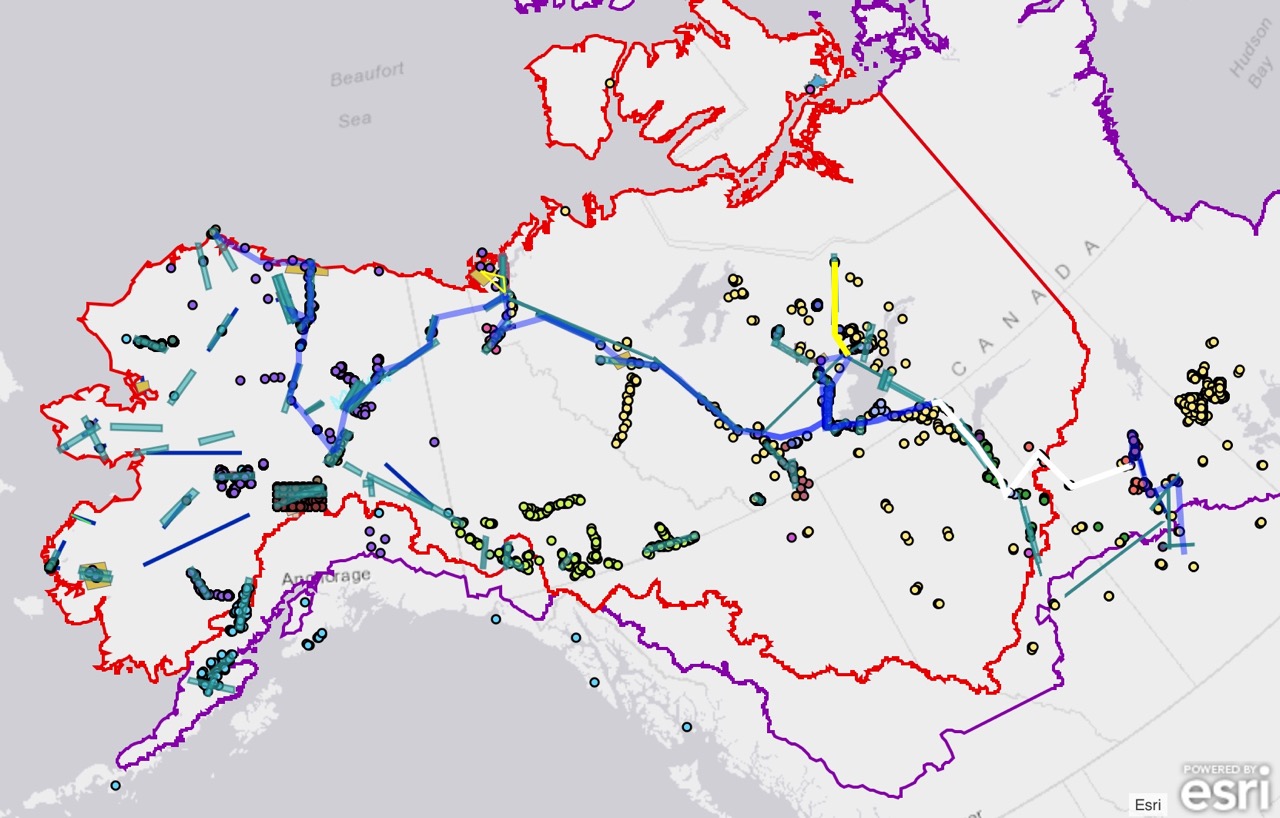
The latest flight calendars and flight line maps will be updated regularly during the ABoVE Airborne campaign at https://above.nasa.gov/airborne.html For questions not answered on the website please contact support@cce.nasa.gov . Logistics and Safety SupportThe 2017 field season is up and running with 21 ABoVE teams in the field this year. We are already supporting many teams with flyouts, field trucks, field gear, and shipping. The Support Offices at Goddard and Fairbanks have been in discussions with many other teams that will arrive this Summer, some in coordination with the Airborne Campaign. We are reworking our support office plans, adjusting to new science team needs this year. In some cases that involves adding gear or services, such as the upgraded camping gear capability out of the Fairbanks Office. In other cases, we are reducing support, as with some office/lab/storage facilities that are no longer needed in Northwest Territories. Additionally, we will be opening operations centers for Airborne Campaign support at the Yellowknife and Fairbanks Airports. Unless we hear of additional needs in Yellowknife, we will likely be releasing the office, lab, and storage space that was so kindly donated to the project through the Government of Northwest Territories last year. We are finalizing a plan to stage gear and shipments through the Arctic Response offices in Edmonton and Yellowknife. 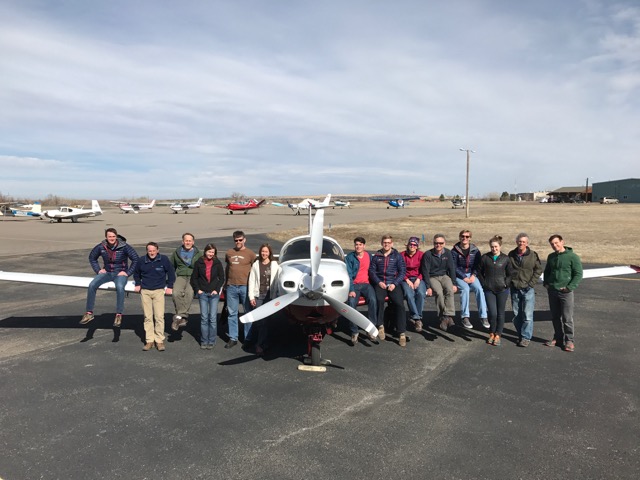
The Wilderness First Aid class in Boulder, taught by Colorado First Aid We have sponsored multiple training courses already this year and are planning more. We have coordinated courses in first aid, aviation dunker training, wilderness first aid (WFA), snow machines, and shotgun training over the last few months. We continue to plan future courses in the May-June timeframe for northern environments field safety, WFA, boat handling, and ATV’s. Dates are not set on these trainings as we are still waiting on a few teams to finalize their Hazard Assessments. All of our training courses are based on the needs identified in the Hazard Assessments. While we cannot accept responsibility to train everyone in all the required courses, we continue to work closely with the field teams to provide or identify appropriate training. We have a new truck this year to meet the demand of our field teams basing out of Fairbanks. The truck is already being scheduled through the Fairbanks Office as of June 1, 2017. 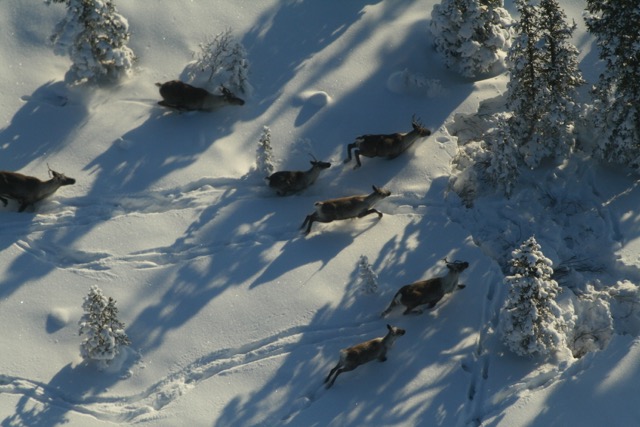
Picture from Mark Hebblewhite from his Fortymile caribou project. If you have any questions, please contact safety@cce.nasa.gov. Have You Engaged in Active Science with NASA using GLOBE's Enhanced Cloud Protocol?
Now that the enhanced GLOBE Cloud Protocol is live, it's time to join the NASA and GLOBE science teams in taking a new look at clouds -- from the ground and from space! New observation and data analysis skills have been added for you to explore and master (as an optional enhancement to the work you are currently doing). Thanks to the newly enhanced protocol, you can now provide additional information that scientists and the GLOBE community can use to compare with satellite data! Explore the new resources:
New Affiliated ProjectsBartsch-01: GlobPermafrost >> Hebblewhite-01: Fortymile caribou herd habitat relationships >> Marsh-01: Hydrology, snow and permafrost in the western Canadian Arctic >> Myers-Smith, Isla: Climate as a driver of shrub expansion and tundra greening >> Quinton-01: Consortium for Permafrost Ecosystems in Transition (CPET) >> Tank-01: Arctic Fire >> Welker-02: Nutritional Landscapes of Arctic Caribou: Observations, Experiments and Models Provide Process-Level Understanding of Forage Traits and Trajectories >> Wheater-01: Changing Cold Regions Network (CCRN) >> New NASA Funded ProjectsBourgeau-Chavez-04: Assessing and Downscaling SMAP data for Organic Soil Fuel Moisture Estimation in Boreal-Arctic Ecosystems >> Keeling-08: Detection, Quantification, and Analysis of Changes in Boreal and Arctic Ecosystems Using Measurements and Models of CO2 and Its Isotopes >> Munger-04: Multi-scale data assimilation and model comparison for ABoVE to identify processes controlling CO2 and CH4 exchange and influencing seasonal transitions in Arctic tundra ecosystems >> Neigh-01: Disturbance, Growth, and Recovery of Boreal Forests Spanning the Satellite Era: 3D Structure, Site Index, and Ecosystem Carbon Flux with Changing Climate >> Rogers-02: Understanding the Causes and Implications of Enhanced Seasonal CO2 Exchange in Boreal and Arctic Ecosystems >> Siqueira, Paul: NISAR Ecosystems and Permafrost Science in the ABoVE Domain >> CalendarApril 19–21, 2017: Earth to Sky Regional Workshop, Yellowknife, Canada January or February, 2018: ABoVE Science Team Meeting |
National Aeronautics and Space Administration

ABoVE
- NASA Official: Jon Ranson | Curator: Carla Evans
- Last Updated:
- Download Acrobat Reader

